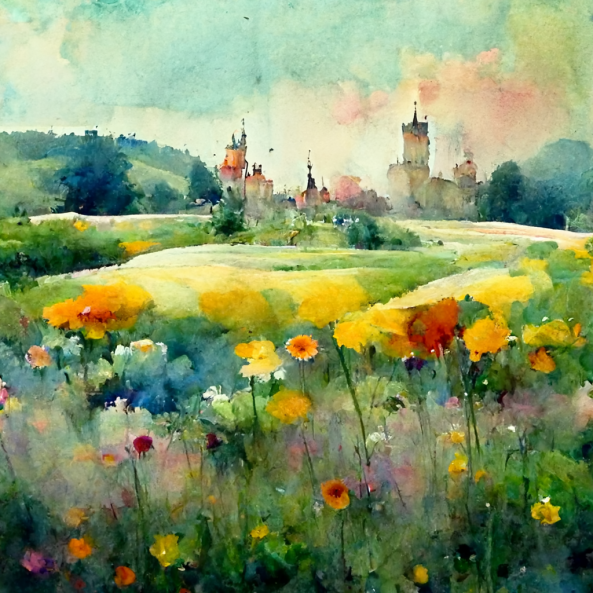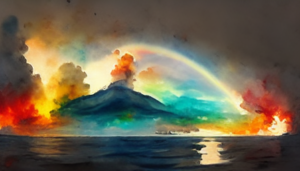Ljostari
LOCATION
CLIMATES RACES Cultures HeroesTimeline:
DA -12800 Heiberg raise portal
-9460 Cromi empire
-400 Mawmen arrives
3646 Third Age the Vular War
4286 Ljostari sinks
4286 Mt. Ljostia erupts
Legend
“Once a heaven of peace and philosophy, then came the Mawmen and Vular, changing Ljostari heaven forever. Now it is but a memory in Ljost Alfar minds and scrolls of Mortal Races.”
History

One of the first, if not the very first, of those things linked to the Astral, which became a Void Garden. The vibrant, low-humming, and dimly glowing Mana Thread attracted beings of many races who followed it to its end, far out in the Void. They camped and interacted with others, and soon a plenitude of diverse individuals shared interests and jointly studied what was brought to the site.
Skjald Valgrif

The island of Ljostari was formed when our world was created and was an island the size of the country. Usai at West Fjella Isle. The Divine Races had only brought some of the former neighbours to this place; thus, it was mostly inhabited by Ljost Alfar, Fautyr, Moss'ari, and T'Aurs, and all three of the Archaic Races.
Skjald Ulrich

The cataclysmic Vampire Wars saw the south end of the country break off and sink beneath the sea in the 1st Cataclysm. Thus, the Fautyr heaven of Niabolta Tio was destroyed.
Slowly recovering, time passed, and a handful of centuries prior to the Vular coming, the Mawmen from Darin came and settled on the southern shores. They built a couple of mighty castles and started to trade and learn what crafting they could. Seemingly, great noble families were exiled, merely lingering to strike back with renewed force when the time was right. Aside from trading and learning, they interfered little with the older races.
The Mawmen presence established several strong and stable trade routes with Darin, importing raw materials like magic glass in bulk to be bought by Moss’ari and Ljost Alfar. The only Kobold colony was far more interested in buying raw materials from The Rim to create Ljosti Bronze—asecret recipe of the Kobolds. The abilities of Ljosti Bronze made an odd bond between Kobolds and Moss’ari, who were eager to get as much of this as they could.
Skjald Vinotis

Shortly after they crossed the Rim, the Vular also came to Ljostari. At first, the humble guests sought friendship and were pleased to find skilled teachers in every aspect of crafting: medicine, philosophy, cooking, and much more. Through more than a millennium, they watched and learnt, and slowly, their arrogance towards equality built. Forgetting that the very same Overlords teaching them was the very same who taught their ancestors at their arrival and thus skilled far beyond Vular comparison.
Thus, envy and malice began to spill into the growing number of Vular, and around 3600 TA began harassing the Ljost Alfar settlements openly, attempting to drive them off Ljostari. culminating in the two-year war breaking out in 3646, when the Ljost Alfar finally had enough and stroked enough to get rid of the swarming plague. As it ended with victory for the Vular at the great clash outside the Capital and they began to raze and pillage, the Divine races stepped out of the Astral in fury, aiding both sides. This ended with Ljostari sinking beneath The Deep Blue, only to have the central mountain erupt as an odd volcano, Mt. Vula, at the edges between the world and the astral.
Skjald Yell'a'Beard
Cartography

Located in between Darin, East Fjella, Midgard, Markeoy, and The Rim, it was heavily influenced by Mildmarsh and Shadowland climates, as well as coastal and highland climates. These climates and their origins give it a diverse Flora, Fauna, and a plenitude of Raw material.
The land bore a resemblance to its wildly created in the void, and the land could easily be called rough. Despite vast grassy steppes or large fields with various crops, there was always a crevasse, valley, kettle, hill, ridge, foothills, mountain, and the like, roughing up the terrain. This was what gave it its charming, wild feel. Add in forests, lakes, streams, and settlements of both the present state and ancient ruins, and you should be able to envision its further enhamcement as a dreamy realm.
On the south-east side of Ljostari, where Mt. Ljostia meets the sea, Ljost Alfar, under Queen Insilnuella Eranvurtal, built their great city of Ljostalia. Soon to melt together and become carved into the mountain itself, just as the dwarves did at the northwestern side. But were the Alfar generally leaned onto the mountain, the Dwarves dug ever deeper into it, to reach its very nerve, the astral within.
Besides the two realms at Mt. Ljostia, two large tribes of T'Aurs had settled there. One in Ghakknak Khųz at Ljostaris most southern peninsula, the other in the Qüiddûn Krôx hills in the northern part of Ljostari. There was also a tribe of Mawnen, who had carved themselves Rygita Buk, a grand fortress in Datylaq Knolls.
From Mt. Ljostari ran a small stream, Asfinus Creek, across the northwestern lands, cutting through the large forest of Jhär, splitting it into SW Jhär and NE Jhär, to then merge with Tiranai Rivlet from Qüiddûn Krôx. Where they met, at Klahaudir's Ford, lived a large enclave of Archaic.
Between Klahaudir’s Ford and the seashores, one of the three Fautyr settlements rested solid at the edge of Mirtap Woods and Happem Ridge, overlooking the river that flowed through Brabal Cracks. The other Fautyr settlements were Qirertio Quartik Ko in Mrakenwood to the east and Aekso Vux at the swampy Phenduur Hills in the southwest.
Southeast of Aekso Vux, in the rough foothills of Mt. Kzaq, lay Pra Kzaq, a large colony of Drakk Alfar, which shared the lands with one of the two Kobold settlements, Juoll Nhaaghi. The other Kobolds resided in the southeastern Fherg Ghergy canyon.
East of Mt. Lhór, 1nto the rocky shore of Laha Cliffs, some Mawmen had built an exile realm, trading heavily with their homelands. North of these, one of two Moss'Ari tribes lived in the lush Yuoel Dhamp hills. The other Moss’Aris lived further north, at the Ferryl Peninsula.
There were also Ogryl settlements in Irr Knolls, Leaflund, and Kthak Shrubs.
When the Vular came to Ljostari the landed east of Laha Cliffs, at Suvia where they where allowed to create a settlement, Thesuvia. From there they spread along the coast, creating small outposts before and after Mt. Lhor, and up the eastern coastline past Mt. Ljostia.
When Thesuvia was razed, and the Moss’Ari made it a sacred memorial site, it became known as Thesuvian Ruins. The second wave, or grand reinforcement as they call it, was prohibited to rebuild Thesuvia, but created a new city, Aivuseht, at the other side of the bay which they named Thevuls Bay.
Skjald Vinotis
Special
Many legends…
Mountains of magic glass… thousands of resource bars… hundreds of objects…
Waggons with Gems… crates with rare coins…
Taken in haste… hit by tsunami wrath… now buried waste…
Skjald Kazumix
Last Updated on 2024-10-27 by IoM-Christian
